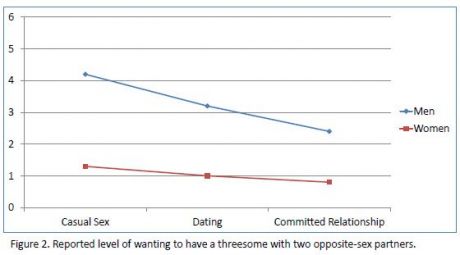Sex
Would You Have a Threesome with Two Opposite-Sex Partners?
The telling results of a new survey on menages à trois.
Posted March 30, 2014
Alternative sexual lifestyles are becoming ever more visible. Chris Ryan’s bestseller Sex at Dawn argues that humans are not monogamous by nature. Daniel Bergner’s What Do Women Want? challenges the view that women are not particularly disposed to casual sex with strangers and multiple partners. Kate Frank’s Plays Well in Groups documents the colorful history of group sex across times and cultures. There is now even an app devoted to making threesomes happen.
Are there really many women and men who are into menages à trois?
There is little research asking people how interested they are in, or how much experience they have with, group sex in general—and even less research into interest in specific types of group sex. (Not all group sex situations, after all, are equally appealing. A woman might have interest in a threesome with a man and another woman, but appalled at an encounter with 10 men. Asking a question about interest in "group sex" in general, then, might not be particularly useful.)
A study just published in the Journal of Bisexuality provides at least a partial answer about interest in specific types of threesome. Researchers Heather Armstrong and Elke Reissing of the University of Ottawa were interested in heterosexual adults' attitudes toward dating and hooking up with bisexual partners of the opposite sex. They asked 720 participants (a mix of Canadian undergraduates and non-students, ranging from 18 to 60 years old with a mean age of 21) about their interest in a threesome with two partners of the opposite sex across three different relationship scenarios—casual sex; dating; and committed relationship.
Who Would Do It?
As you can see in the graph below, regardless of the proposed relationship type, very few women showed interest in having a threesome with two men if given the opportunity. On a scale of 0 (completely disagree) to 6 (completely agree), women’s desire for an MFM (male-female-male) threesome barely surpassed 1 in the “best case” scenario—casual sex.

Men’s desires told a different story. In the casual-sex context, men leapt at the opportunity to have a threesome with two women, their desires far surpassing the midpoint of the scale. Although this desire was lower for more involved relationship categories, men’s interest in an FMF (female-male-female) threesome still hovered at or slightly below the mid-point of the scale for both dating and committed relationship partners.
Who Finds the Idea Arousing?
The results were similar when participants were asked how arousing they found the idea or fantasy of having a threesome with two opposite-sex partners: Women’s average score (across all three relationship categories) was a meager 1.62 on the same 0-6 scale; the men’s average was a whopping 4.48. This gender difference was statistically significant and quite large (for any stats geeks out there: Cohen d’s was = 1.50).
Who's Already Done It?
Finally, only 2 percent of women said they’d already had an MFM (and all had reported only having one such experience); by comparison, a full 10 percent of men said they’d had an FMF (and half of them reported having had more than one such experience, with a few reporting up to 20).
The gender difference is striking, if perhaps not surprising. Men are generally more sexually adventurous and accepting of casual sex in all its forms than are women. More specifically, a threesome with two women is the ultimate fantasy of many heterosexual men, a conquest above all conquests and twice the body parts they usually enjoy sexually. For a woman, on the other hand, a threesome with two men is much more of a social taboo. Some don’t want to have casual sex with one guy, let alone two. It also carries a range of physical safety and power dynamics concerns.
Of course, this survey doesn’t give us a complete picture of people’s interest in threesomes—women were not asked about an FMF scenario, for example, and men were not asked about a MFM scenario. The gender difference might be much smaller, nonexistent, or even reversed, as anecdotal evidence suggests both women and men are more interested in a threesome with two women than with two men. (The reasons for this require their own post, but I suspect sexual orientation issues play an important role.)
That notwithstanding, men today are clearly more interested in at least some forms of group sex than are women. I can’t wait to see how much this gap will close over the next few decades (if at all) as we continue, slowly but steadily, to become more accepting and understanding of nontraditional sexual expression.
Have a casual sex story to share with the world? That's what The Casual Sex Project is for.
Follow me on Twitter @DrZhana for daily updates on the latest in sex research, check out my website for more information about me, or sign up for my monthly newsletter to stay up up to date with all my sex research- and sex education- related activities.
References: Armstrong, H. L.,& Reissing, E. D. (2010, November). Gender differences in attitudes toward bisexual partners. Poster session presented at the annual meeting of The Society for the Scientific Study of Sexuality, Las Vegas, Nevada.
Armstrong, H. L., & Reissing, E. D. (2014). Attitudes toward casual sex, dating, and committed relationships with bisexual partners. Journal of Bisexuality. E-pub ahead of print. doi:10.1080/15299716.2014.902784




